Mid-21st Century Modern: That Jetsons Architecture
The artists and animators working on “The Jetsons” were inspired by the futurist architecture popping up around Los Angeles
![]()
This is the 21st in a 24-part series looking at every episode of “The Jetsons” TV show from the original 1962-63 season.
The 21st episode of “The Jetsons” originally aired on February 17, 1963 and was titled “TV or Not TV.”
Much like both “Elroy’s Pal,” and “Elroy’s TV Show,” this episode ostensibly gives viewers another look behind the scenes of television production. George and Astro are involved in a misunderstanding (isn’t that always the way?) where they think they’ve witnessed a robbery. In fact, it was just a TV shoot for “Naked Planet,” a spoof on the late 1950s ABC show “Naked City.” Thinking that mobsters want to snuff him out, George goes into hiding with Astro at Mr. Spacely’s vacation home in the woods.
That vacation home – Mr. Spacely’s “old fishing cabin” — is one of my favorite examples of Jetsonian architecture. Probably because the building bears a striking resemblance to the villain Vandamm ‘s hide-out in Alfred Hitchcock’s 1959 film North By Northwest.
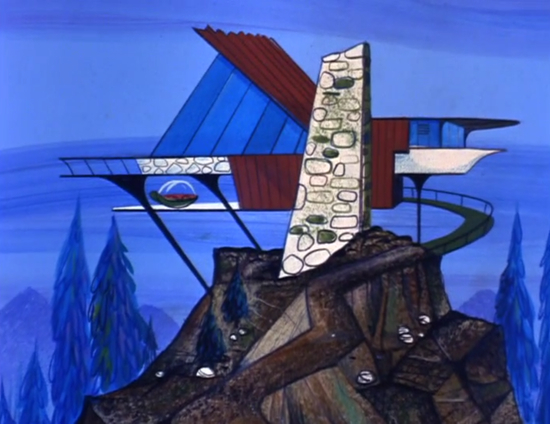
Mid-21st century design in a vacation home of the future (1963)
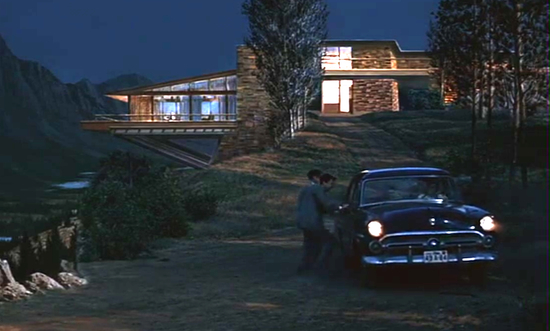
Screenshot from the 1958 Alfred Hitchcock film North by Northwest
Sadly, the home in North by Northwest is not a real house that you can visit, but was instead built on an MGM set.
Both the Jetsons version and the Hitchcock version have the signature of midcentury hyper-modernism or, as it came to be known, Googie: dramatic sloping roofs, plenty of glass, steel, maybe a little plastic, and some stone when you wanted a touch of that comfortable earthy flair.
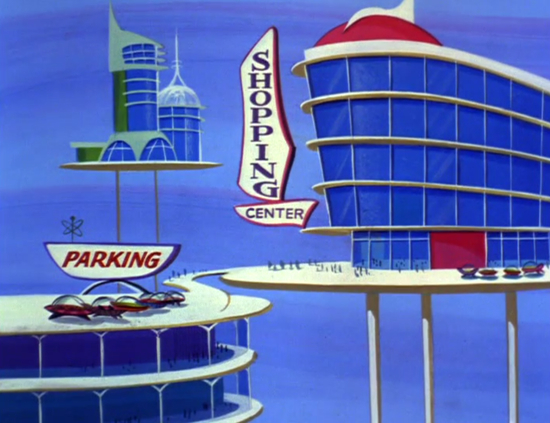
Shopping center from the 21st episode of “The Jetsons” (1963)
Danny Graydon, author of The Jetsons: The Official Guide to the Cartoon Classic, has deemed the look “mid-21st century modern” — a play on the term “midcentury modern,” back when the century in question happened to be the 20th.
The architecture from “The Jetsons” clearly takes cues from architects who worked in the midcentury modern/Googie style, like John Lautner and Oscar Niemeyer. Jetsonian architecture also seems to draw from the work of Charles Schridde in his series of ads for Motorola in the early 1960s which ran in the Saturday Evening Post and Life magazine.
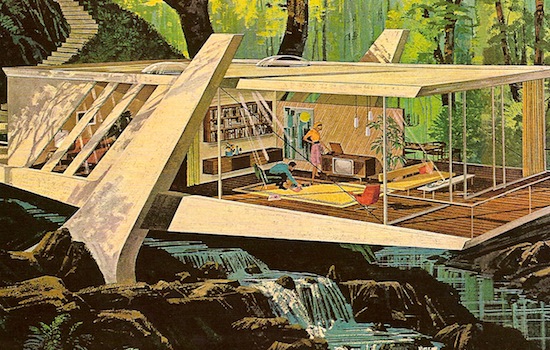
Motorola ad illustrated by Charles Schridde in the early 1960s showing midcentury modern design

TV production studio in the Jetsons universe (1963)
But as I pointed out in my post about Googie architecture from last year, the artists and animators working on “The Jetsons” didn’t really need to leave their own backyards for inspiration. The Hanna-Barbera Studio which produced “The Jetsons” was in Hollywood and in the late 1950s and early 1960s buildings all across Los Angeles had that mid-20th century modern look that would become identified as Jetsonian.
The people working at Hanna-Barbera could find inspiration at Disneyland’s Tomorrowland in Anaheim, dozens of Googie coffee shops in Southern California, and maybe the most iconic Googie building in L.A. (if only for its visibility to tourists), the Theme Building at the Los Angeles International Airport.
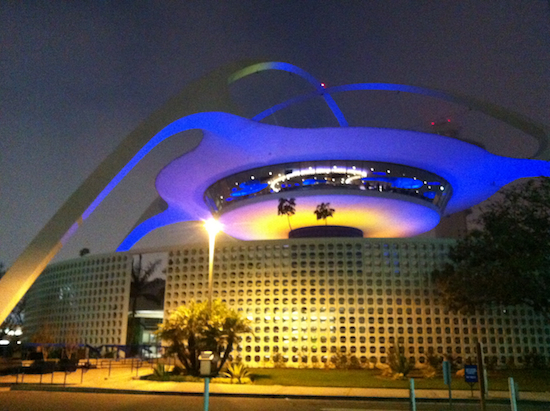
The Theme Building at the Los Angeles International Airport (Photo: Matt Novak, 2013)
Another building which clearly inspired the architecture of the Jetsons universe was the Chemosphere. Designed by John Lautner and built in 1960, the home looks like it could take off into the sky like a flying saucer at any moment. The Chemosphere sits in the Hollywood Hills and has been an incredibly popular shooting location for films and TV shows that need a futuristic feel — including a 1964 episode of “The Outer Limits” set in the 21st century.
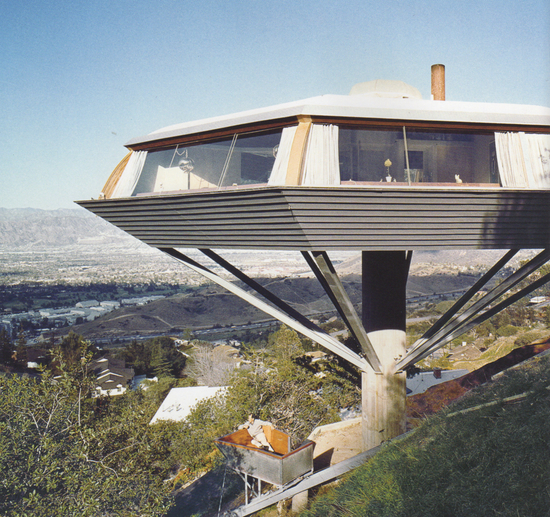
John Lautner’s Malin Residence “Chemosphere” built in 1960 in Hollywood, CA
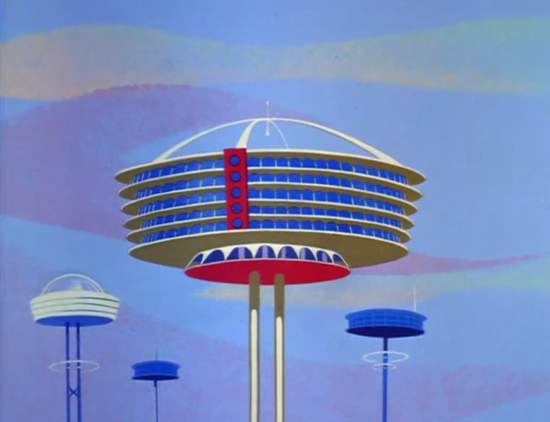
The apartment building shot that opens most episodes of The Jetsons (1963)
The architecture of the Jetsons is a reflection of the future, but even more so a reflection of that late-1950s and early 1960s Space Age design we so associate with the golden age of futurism. Well, someone’s golden age.
And just as we’ve seen mention of the Jetsons become a kind of shorthand way to talk about the technology of past futures, so too has “that Jetsons look” eclipsed Googie as the descriptor of choice for people talking about architecture from the futures that never were. People may think you’re saying Google, when you mean Googie. But fifty years after its debut, there’s no mistaking the Jetsons landscape.
![]()
This is the 21st in a 24-part series looking at every episode of “The Jetsons” TV show from the original 1962-63 season.
The 21st episode of “The Jetsons” originally aired on February 17, 1963 and was titled “TV or Not TV.”
<object align="middle" classid="clsid:d27cdb6e-ae6d-11cf-96b8-444553540000" codebase="http://download.macromedia.com/pub/shockwave/cabs/flash/swflash.cab#version=6,0,40,0" height="316" id="embed" width="410"><param name="allowScriptAccess" value="always"/><param name="allowFullScreen" value="true"/><param name="flashVars" value="mediaKey=3c003794-6cf2-4f93-9b76-169639ad622f&config=wbembedplayer.xml"/><param name="quality" value="high"/><param name="src" value="http://www.thewb.com/player/wbphasethree/wbvideoplayer.swf"/><param name="flashvars" value="mediaKey=3c003794-6cf2-4f93-9b76-169639ad622f&config=wbembedplayer.xml"/><param name="allowscriptaccess" value="always"/><param name="allowfullscreen" value="true"/><embed align="middle" allowfullscreen="true" allowscriptaccess="always" flashvars="mediaKey=3c003794-6cf2-4f93-9b76-169639ad622f&config=wbembedplayer.xml" height="316" id="embed" quality="high" src="http://www.thewb.com/player/wbphasethree/wbvideoplayer.swf" type="application/x-shockwave-flash" width="410"></embed></object>
Much like both “Elroy’s Pal,” and “Elroy’s TV Show,” this episode ostensibly gives viewers another look behind the scenes of television production. George and Astro are involved in a misunderstanding (isn’t that always the way?) where they think they’ve witnessed a robbery. In fact, it was just a TV shoot for “Naked Planet,” a spoof on the late 1950s ABC show “Naked City.” Thinking that mobsters want to snuff him out, George goes into hiding with Astro at Mr. Spacely’s vacation home in the woods.
That vacation home – Mr. Spacely’s “old fishing cabin” — is one of my favorite examples of Jetsonian architecture. Probably because the building bears a striking resemblance to the villain Vandamm ‘s hide-out in Alfred Hitchcock’s 1959 film North By Northwest.

Mid-21st century design in a vacation home of the future (1963)

Screenshot from the 1958 Alfred Hitchcock film North by Northwest
Sadly, the home in North by Northwest is not a real house that you can visit, but was instead built on an MGM set.
Both the Jetsons version and the Hitchcock version have the signature of midcentury hyper-modernism or, as it came to be known, Googie: dramatic sloping roofs, plenty of glass, steel, maybe a little plastic, and some stone when you wanted a touch of that comfortable earthy flair.

Shopping center from the 21st episode of “The Jetsons” (1963)
Danny Graydon, author of The Jetsons: The Official Guide to the Cartoon Classic, has deemed the look “mid-21st century modern” — a play on the term “midcentury modern,” back when the century in question happened to be the 20th.
The architecture from “The Jetsons” clearly takes cues from architects who worked in the midcentury modern/Googie style, like John Lautner and Oscar Niemeyer. Jetsonian architecture also seems to draw from the work of Charles Schridde in his series of ads for Motorola in the early 1960s which ran in the Saturday Evening Post and Life magazine.

Motorola ad illustrated by Charles Schridde in the early 1960s showing midcentury modern design

TV production studio in the Jetsons universe (1963)
But as I pointed out in my post about Googie architecture from last year, the artists and animators working on “The Jetsons” didn’t really need to leave their own backyards for inspiration. The Hanna-Barbera Studio which produced “The Jetsons” was in Hollywood and in the late 1950s and early 1960s buildings all across Los Angeles had that mid-20th century modern look that would become identified as Jetsonian.
The people working at Hanna-Barbera could find inspiration at Disneyland’s Tomorrowland in Anaheim, dozens of Googie coffee shops in Southern California, and maybe the most iconic Googie building in L.A. (if only for its visibility to tourists), the Theme Building at the Los Angeles International Airport.

The Theme Building at the Los Angeles International Airport (Photo: Matt Novak, 2013)
Another building which clearly inspired the architecture of the Jetsons universe was the Chemosphere. Designed by John Lautner and built in 1960, the home looks like it could take off into the sky like a flying saucer at any moment. The Chemosphere sits in the Hollywood Hills and has been an incredibly popular shooting location for films and TV shows that need a futuristic feel — including a 1964 episode of “The Outer Limits” set in the 21st century.

John Lautner’s Malin Residence “Chemosphere” built in 1960 in Hollywood, CA

The apartment building shot that opens most episodes of The Jetsons (1963)
The architecture of the Jetsons is a reflection of the future, but even more so a reflection of that late-1950s and early 1960s Space Age design we so associate with the golden age of futurism. Well, someone’s golden age.
And just as we’ve seen mention of the Jetsons become a kind of shorthand way to talk about the technology of past futures, so too has “that Jetsons look” eclipsed Googie as the descriptor of choice for people talking about architecture from the futures that never were. People may think you’re saying Google, when you mean Googie. But fifty years after its debut, there’s no mistaking the Jetsons landscape.
/https://tf-cmsv2-smithsonianmag-media.s3.amazonaws.com/accounts/headshot/matt-novak-240.jpg)

/https://tf-cmsv2-smithsonianmag-media.s3.amazonaws.com/accounts/headshot/matt-novak-240.jpg)